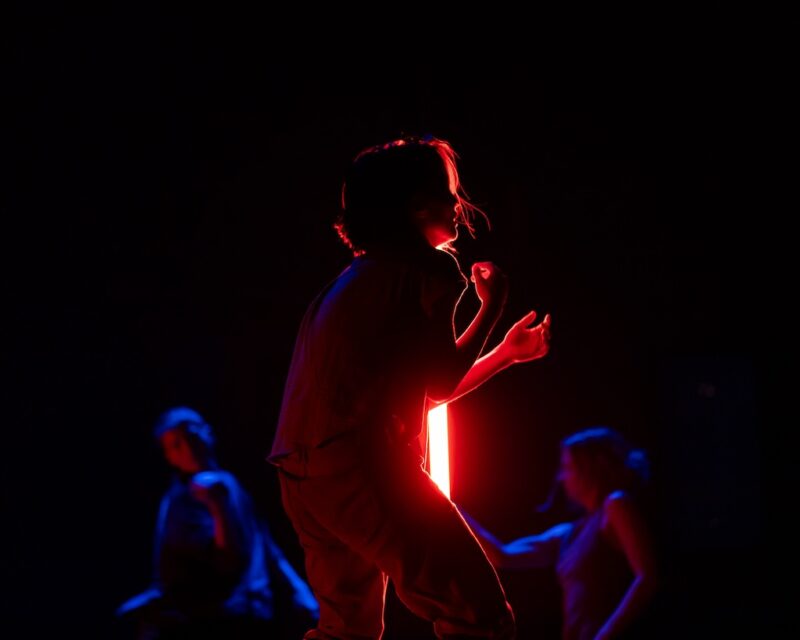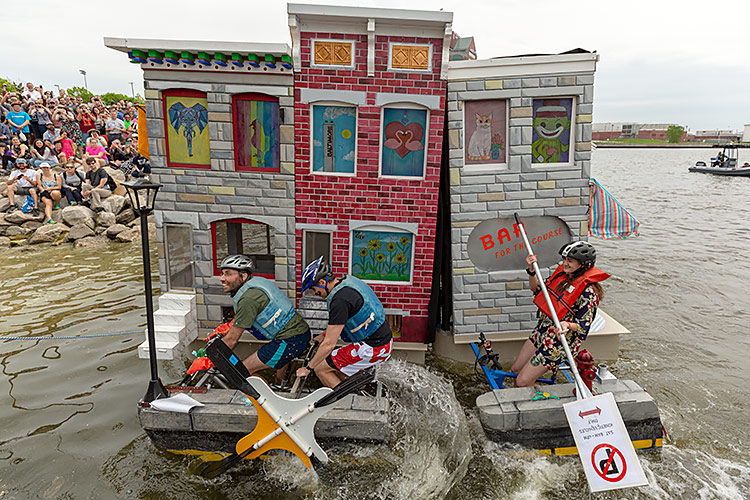There is something singularly fascinating about a piece of art that is larger than life. It engages the senses in a way that art of ordinary size can’t, surrounding the viewer and drawing them in to the world within the piece. It can be simultaneously intimidating and awe-inspiring—mystical, set apart, yet commanding respect for its majesty. A chessboard so big that real people could be used as the pieces, paintings that take up an entire wall, full of swirling colors and multiple dimensions—these unusual and captivating pieces create a sense of fantasy, filling the small gallery at the Carroll Arts Center with life.
Perhaps the piece that commands the most attention is the giant dandelion in one corner—upon stepping inside, visitor’s eyes are immediately drawn to it. It appears to grow right out of the carpet, so natural it seems on its bending stem, its expansive leaves shading the ground. It is fashioned out of fabric, the soft edges blending like the petals of a true flower. The piece was created by Rachel Held, the same artist who made the chessboard. That chessboard, too, is made of fabric, in bright yellows and greens, like those of the dandelion. Rather than using the traditional checkered squares, Held employs a pattern of circles, which as they intersect create flowers. The chess pieces themselves are almost cartoonish, polka dotted toadstools, lily-pad like flowers, and feathery tufts of moss rule the board alongside the ordinarily styled pawns. Both of Held’s pieces feel as wholesome and organic as living plants, as if they sprouted up in a forest meadow.
Equally engaging are the pieces by Steven Pearson, two abstract paintings on opposite walls. “Too Good, Too Evil” is particularly captivating, using an electrifying array of color and swirling patterns. While on the surface it appears turbulent, when one looks closer a deeper order is revealed. Every element in the painting is carefully balanced, the pattern on one side a mirror image of the other, and although a large palette of colors is used, they are all subtly repeated throughout. Bold, geometric shapes make up the body of the pattern, but their clean edges unify them and preserve order. Likewise, while the diagonal lines lend the piece a sense of excitement and urgency, stability is maintained by an equal amount of horizontal and vertical lines. Similarly, the second painting, “Some Heroes Step Forward,” is broken into blocks. They are just irregular enough to catch the viewer’s attention, but not so much so that the piece becomes chaotic. The pattern is almost like the grain of wood, which combined with muted colors gives the painting an earthy, serene feeling.
An untitled work by Katherine Tuz-Lau Mann, taking up the entirety of one wall, is another example of carefully ordered chaos. It is made up of twisting shapes which appear indistinct at a distance, yet are actually made up of smaller lines that form an intricate pattern. Ribbons tied in bows, clusters of grapes, and other smaller images make up the larger ones, giving the piece three dimensionality and depth. Its flat black background bespeaks danger, but the effect is lightened by the use of shimmering silver and brighter yellows and blues. Mann’s second piece, “Net,” has an even greater sense of complexity with its multiple layers and mixed elements. She creates cutouts, in a delicate crisscross pattern that is almost like lace, which shows through to a backdrop of magentas and purples. The brightness behind the cutouts contrasts with the black and silver of the main painting, underlining the subtle shapes in the foreground.
The sculptures of Howard Riopelle, fashioned out of hammered metal, emphasize elegance through minimalism. The first, his “Hare Ball,” is simple with clean edges, using the repetitive shape of a rabbit’s head with long ears. These shapes form two intersecting, unbroken circles, giving the piece a sense of almost mesmerizing unity. His “Celtic Bunny Knot” is similar, using the same element again and again to create a continuous pattern. Riopelle’s final piece, which is a collaboration with Gayla Lee, is a trio of sea turtles titled “Honu (Magical Hawaiian Greenback).” Each turtle is comprised of a hammered metal frame and a sea green glass shell, the three of them linked together in a harmonious curve.
The final piece is done by Randi Reiss McCormack, a large mural painted directly onto the wall. It centers around a young girl with two blond braids, wearing an old-fashioned blue dress. She is surrounded by shades of charcoal and gray, creating a stark contrast and immediately drawing the attention to her. The girl is the embodiment of innocence, a vision of light and the security of childhood. The images around her, however, give the painting a distinct feeling of darkness. Shadowy black, they form the shapes of toys—not whimsical but eerie, a leering army encroaching in upon the girl. They swirl around her, threatening to swallow her up, yet she smiles on beatifically in a halo of light, unconcerned and untouched by the chaos by which she is surrounded. Although diverse, the works of these artists are unified by the intense richness of emotion that they evoke. They all accomplish it in different ways, but each piece speaks to the viewer on numerous levels, engaging them and connecting them to what they see. They tower over the visitors, standing taller than they do, yet these super-sized masterpieces inspire them like no others could.
Emma West is a current student at McDaniel College.








